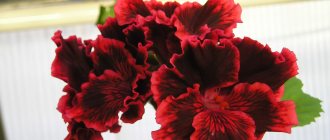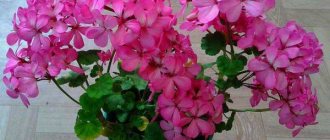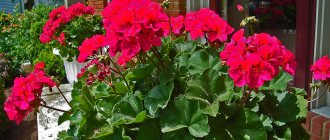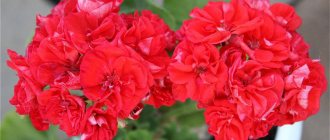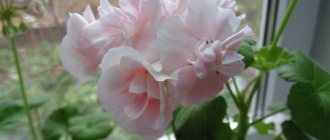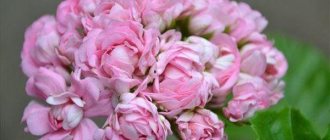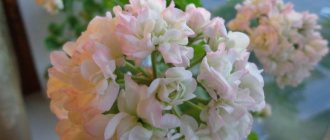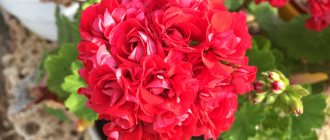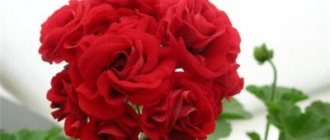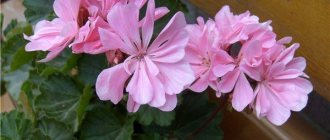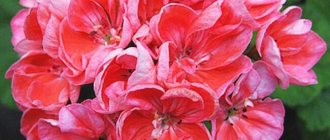Good luck in growing. Alena February 06, 2022, 21:48 // Guest book –
I want to say a big thank you to Alena for the wonderful children. All so beautiful, juicy and strong. Svetlana February 06, 2022, 12:32 // Guest book –
Of course you can, email the list. Alena July 26, 2022, 08:15 // Contacts – Flower Paradise
Thank you, Lyudmila! Good luck in growing. Alena July 26, 2022, 08:15 // Guest book –
Unfamiliar pelargonium: facts that will change your attitude towards “grandmother’s flower”
What do you know about pelargonium? Yes, yes, about that same pelargonium, which is often called geranium, or crane grass, or - even funnier - oak. About the one that from ancient times, decorating the windows of our grandmothers, grew in chipped bowls in the ground, similar to cement, and bloomed lushly and brightly.
What do you know about common pelargonium?
Do you know that pelargonium comes in white, pink and red? Just recently I thought exactly the same thing and firmly knew that there would never be pelargonium in my house. The bitter smell of its leaves seemed very tasteless to me.
Perhaps, to this day, I would not have changed my attitude towards them if I had not once happened to get into the garden of elderly Kaluga residents, fans of dahlias. They asked to take photographs for a local exhibition. Armed with a camera, I went to photograph the dahlias. They have a small plot, four hundred square meters of land. There is not a single bed - all dahlias, and on the high veranda in funny old saucepans, hanging down no less than one and a half meters, a solid wall of multi-colored ivy-leaved pelargoniums grew.
House of Kaluga flower growers, photo by the author
It took my breath away with delight; I had only seen such beauty in pictures in magazines. And it turned out that the foliage of this variety has no smell at all. It was then that the firm decision to never keep pelargonium in the house lost its firmness.
I was embarrassed to ask older flower growers for cuttings, and I understood that these plants are not for windows, they are for balconies and verandas, and I have neither one nor the other. Not yet knowing that this was possible, I began to look for something similar, but compact, so that I could keep it on the window in my apartment.
Pelargoniums conquer once and for all. You just need to get to know them better
Very soon I found a virtual club for pelargonium lovers on the Internet. This is a community of passionate people, fans of an amazing plant that has captured my heart once and for all. These people do a lot to popularize pelargoniums in Russia, they have created a catalog of species and varieties that are in private collections, are happy to share observations about all aspects of the life of pelargoniums, collect information about these plants bit by bit, and hold exhibitions.
It was there that I learned how diverse pelargoniums can be - from modest species forms to decorative luxurious bushes strewn with large inflorescences. It was there that I found the plant of my dreams. Now I have about 200 varieties and species of pelargonium in my collection, and the bitter smell of the foliage no longer seems unpleasant to me.
Pelargoniums on a walk, photo by the author
Would you like to know a little more about this amazing plant? Then let me bring to your attention a brief classification of pelargoniums that can be found in collections.
How to change the care of geraniums in the spring so that by summer they bloom magnificently with a bunch of umbrellas
Don't waste time - take care of pelargonium now.
Fireworks, fellow flower growers!
Zonal pelargonium
(in the world – simply “geranium”) was, is and will be
a favorite plant
among Russian lovers of decorating a house, balcony or garden with beautiful flowers. I’m even a little offended when they call her “grandmother’s flower” with some degree of disdain.
I am sure that in the 21st century, pelargonium is capable of giving heat to newfangled ornamental plants due to its exceptional beauty combined with the same exceptional unpretentiousness... And if you also take a little care of the bush in the spring, then by summer it will be covered with numerous umbrellas, tirelessly replacing each other.
Every year, dozens (and maybe hundreds!) of new varieties of zonal pelargoniums are developed. And one is more beautiful than the other.
In the photo you see Denise Sutarve - leaders in demand among sellers and collectors
Yes, geranium is a plant with a winter dormant period, and this fact cannot be ignored. In spring, with the return of active sun, the life of pelargonium changes radically.
And our task, comrades, is to become a reliable assistant who knows the seasonal wishes of a flower. Actually, my today’s publication is dedicated to them.
A beautiful crown is not only a tribute to aesthetics. But there is also room for new and new inflorescences
If I were asked: “Which of the spring activities is the most important for beautiful geraniums?”, I would, without hesitation, answer: “Definitely, pruning.”
. Unfortunately, many pelargonium owners find it a pity to cut their beauties, especially if buds have appeared on them. And therein lies the big mistake.
Please don’t be afraid: new shoots will definitely come out of the stumps
Yes, and calling geranium after winter “Beauty” is only a stretch. The shoots stretch out, the leaves turn yellow and fly off. And only pruning will return the decorative effect to the bald redneck:
- trim the geranium, leaving stumps from several internodes;
- it is advisable to leave a few leaves so that your favorite plant continues to participate in photosynthesis and continues to evaporate moisture to avoid flooding;
- root the cuttings to get new bushes, give them to friends or plant them in a flowerbed in the summer;
- be sure to reduce watering, since due to the loss of the crown, pelargonium will evaporate moisture several times slower.
And the summer will be beautiful!
Remember that the more young shoots, the more space for inflorescences.
To replant or not?
Zonal pelargonium is tolerant of poor soil, but in fresh soil it grows more actively and blooms more luxuriantly. I advise 2 weeks after pruning to transplant the plants into a new pot, which is 2 cm larger than the old one, and nutritious soil.
If for some reason you do not want to change the place of residence of the geranium, then in the second year of life in the same soil, focus on regular feeding. This will replenish the soil's resources, stimulating growth and flowering. I believe that 2 years is the maximum that a geranium can last in a pot without loss without replacing the soil.
Species pelargonium
Pelargoniums, which are found in nature in the wild. About 200 species of this plant are found in its habitats in southern Africa, in the Cape Province. First of all, they are interesting because without them not a single modern variety would exist. Some of the species of pelargonium can be grown quite easily in apartment conditions.
On the left is the species pelargonium p. fragrans, on the right is its hybrid - fragrant pelargonium 'Ardwick Cinnamon', with the smell of cinnamon. Photo by the author
Pelargoniums of this group amaze gardeners with an amazing variety of forms. They are so different that it is impossible to believe that they belong to the same genus. Among them you can find plants with caudex trunks, similar to bonsai; plants with leaves more like carrots; with flowers that look like exotic insects.
Pelargonium April Snow - what kind of flower is it
The culture belongs to the genus Pelargonium from the Geraniaceae family. This genus includes a large number of different plants that grew naturally or were bred by breeders. Some flower lovers, unknowingly, call it April Snow geranium; it belongs to the zonal type.
The culture is characterized by lush inflorescences of a delicate shade
Fragrant pelargoniums
These are hybrids of pelargonium species. They are grown for their beautifully carved foliage and the pleasant aromas that the leaves emit. In the collections you can find scents with the scent of lemon and mint, rose and pineapple, with perfumery and confectionery scents, with the scent of cinnamon and apple, lilac and coconut, with resinous forest aromas.
Fragrant pelargonium with a sweet smell 'Fillicifolium'. Photo by Ekaterina Kotskaya
It is commonly believed that fragrant pelargoniums have simple and uninteresting flowers, but this is not so; there are many varieties of fragrant pelargoniums with large and beautiful flowers.
Description of appearance
This plant is characterized by an underground rhizome consisting of alternating thick and thin sections. A short stem rises above the ground. It is typical for this pelargonium to shed its leaves. They age early and at the time of flowering the plant has an unattractive appearance.
Pale yellow flowers form on a few peduncles. Each of them forms 2-5 small flowers. They have a short flowering period.
Flowers can be of different colors, including:
- pink;
- white;
- yellow (more varieties of yellow pelargoniums and tips for caring for them can be found here);
- peach;
- orange;
- red.
Pelargonium Angels
Bush or ampelous plants with charming numerous small flowers, somewhat reminiscent of the flowers of royal pelargonium.
Inflorescence of pelargonium 'Eskay Verglo' from the Angels group. Photo by the author
The small flowers of plants of this group are two-colored. A spectacular combination of lilac, purple or pink with white gives the bush a particularly elegant look.
Numerous small two-color flowers are a distinctive feature of this group of pelargoniums. Photo by the author
Many varieties have fragrant leaves and bloom beautifully all summer.
Pelargonium Gosbrook Robyn Louise
Dwarf pelargonium Gosbrook Robyn Louise is a wonderful choice for the home. Small neat bushes of this variety of pelargonium, as in the photo, bloom profusely and can decorate any windowsill.
The plant does not have a high growth rate, does not strive to grow upward, the shoots form a dense spreading crown. The leaves of this variety of pelargonium, like those of other stellars, are seriously different from the rounded foliage of classic zonal varieties. But this only adds charm to the bushes until double pink and lilac flowers appear above them. A characteristic feature of the corollas is their concave petals, reminiscent of a tiny boat.
Zonal pelargoniums
The most famous group of pelargoniums with brightly colored flowers and rounded leaves with a clearly defined stripe - a zone. This group includes many different types, differing in growth form and flower color.
Miniature zonal pelargonium 'Cupid', the photo shows how small it is. Photo by the author
According to the growth form, standard, dwarf and miniature pelargoniums are distinguished. Based on the shape of the flowers , rosebud, tulip, carnation, cactus and star pelargoniums are distinguished.
Zonal pelargonium with cactus flowers 'Mrs. Salter Bevis', photo by the author Flowers of zonal pelargoniums have a variety of colors, they can be one-color or two-color; with a border along the edge or with contrasting spots on the petals (phlox), with a scattering of small colored splashes (speckled), with small contrasting spots and dots in the center of each petal (bird eggs). Inflorescence of zonal tulip-shaped pelargonium 'Emma fr. Bengtsbo'
The color of the leaves of zonal pelargoniums is also very interesting. They can be painted in two or three primary colors in various combinations of green, white, yellow, brown, red and even almost black.
You see how diverse they are - pelargoniums! Everyone can find a plant for themselves in this variety.
- Fans of exotic plants will definitely find it among the alien-like species.
- Adherents of aromatherapy will find their pelargonium among the fragrant ones.
- If you live in the country all summer, you simply need royal, ivy-leaved and standard zonal pelargoniums - they will decorate your garden.
- Do you spend the whole summer in the city? Your balcony and window sill can be decorated with ivy-leaved and zonal dwarf and miniature pelargoniums.
Pelargonium ivy 'Crock-O-Day' and 'Sandra Lorraine', photo by the author
Pelargonium Rushmoor Golden Ruffles
Like a true miniature, the Rushmoor Golden Ruffles pelargonium grows very slowly, readily produces side shoots and blooms profusely.
The variety can rightfully be classified as variegated, since the small golden leaves of pelargonium show a dark orange-brown zone in the sun. The inflorescences consist of delicate pink-salmon star-shaped flowers with elongated, split petals. The color of the corolla is heterogeneous. Towards the center and along the edges of the intricately curved petals, the shade loses intensity. Bright orange stamens are visible in the center of the flower.
The variety is ideal for home growing and can easily be placed on an apartment windowsill.
How to grow pelargoniums
Another argument in favor of this culture is that almost all types of pelargoniums are easy to care for. They are quite undemanding when it comes to the composition of the soil mixture. The most common recipe for soil mixture for pelargoniums is this:
- 3 parts of purchased peat-based soil,
- 1 part coarse sand
- 1 part loamy garden soil.
Maintenance will not be difficult, the main thing is to remember and follow the rule: do not overfill! Pelargonium does not like excessive watering and stagnation of water in the pan. Watering should be regular but moderate.
Species pelargonium p. lanceolatum and variegated dwarf star pelargonium. Photo by Ekaterina Kotskaya
If I have convinced you, and you have already decided that in the spring you will get a rooted cutting of zonal pelargonium, then wait until it grows to 5-7 cm, transplant it into a pot 8-9 cm in diameter and pinch the crown. Dwarf and miniature varieties do not require careful shaping, as they themselves easily bush and form a dense crown. After some time, standard pelargonium will need to be transplanted again into a pot with a diameter of 11-12 cm.
You can choose pelargoniums for your home or garden in our catalog, where a wide range of products from large online stores of seeds and planting material is presented. Choose pelargoniums .
When the first buds begin to appear, you need to feed the plant with fertilizer with a high potassium content (any fertilizer for tomatoes or potassium nitrate will do), alternating it with a full complex one. By keeping pelargonium “in good shape” with fertilizing, you can achieve continuous flowering from spring to late autumn, and by providing illumination with fluorescent lamps, you will help it bloom even in winter.
Ivy-leaved pelargonium, photo by the author
Invite pelargonium into your home. When it’s damp autumn or cold winter outside, when you lack bright flowers, the smells of the garden, when you risk falling into autumn hibernation, a plant that is now fashionable, but so old and familiar to us from childhood, can help you out - pelargonium.
Add a comment Cancel reply
You must be logged in to post a comment.
I offer rooted cuttings of pelargonium Zonartic 'Lovely Vera' (cutting, recently rooted) - 3500 Orange Ricard (Fibrex) - 700 Fée Cerise Polina - 500 RESERVATION, 500 Monica Klauber - 300 Red Pandora - 400 Boniface Butterfly - 200 Silk Aurora - 400 Lara Marjorie — 2500 (already a bush, autumn rooting, 0.5 in a pot, several growing points) this one is sold, there is one more pot.
Related posts:
Posted by: sisadmin
Related posts '
Characteristic
April Snow Pelargonium is a rosebud variety. This category of pelargoniums is capable of rapid growth while maintaining compactness.
It is impossible to convey the unusual colors of april snow pelargonium in a description; it definitely needs to be seen. Its color directly depends on the growing conditions, and all the splendor of its beauty is revealed under the influence of sunlight.
Pelargonium April snow
The same flower will grow completely different with limited access to light. Its petals will be deathly pale, thinned, with an aristocratic porcelain tint.
If you grow a flower under maximum lighting, the petals will acquire a delicate pink color, the edging of each will become bright red.
The core of each bud is painted in a dark green shade, surrounded by delicate, airy, corrugated petals, this combination is reminiscent of the first spring shoots that make their way through the April snow.
Characteristics and description:
- the inflorescences are dense and lush, consisting of many buds, up to 20 on one bush;
- color – variations of white, pink, light green;
- bush - low-growing and lush;
- petals – delicate, corrugated;
- tricolor buds, shaped like roses;
- the leaf is light emerald, large, smooth, with a characteristic brown stripe in the middle.
Pelargonium April Snov blooms all year round, it is not greedy for buds, it keeps the inflorescences on the stem for a long time, constantly releasing flower stalks on each branch.
Interesting! The bush is very compact, does not grow wide, and therefore does not require much space. A flower pot with pelargonium April Snov can easily fit on a narrow windowsill.
Pelargonium Kitbridge Vic Caws June Patricia
Dwarf pelargonium Kitbridge Vic Caws June Patricia, delighting with bright scarlet flowers, is a godsend for the windowsill. The inflorescences reminiscent of “Christmas stars” will not allow you to forget about your favorite holiday even in summer, and the foliage, which shows all the signs of decorative in the light, will delight you even in winter.
In good light, chocolate-colored spots are clearly visible on the leaf blades. The bush is easy to shape and blooms profusely.
Features of cultivation
Pelargonium April snow belongs to the zonal type. If you do not pinch it, the stem of the plant will stretch upward; if formed correctly, it will turn into a lush “paradise” shrub.
The soil
Specialized flower shops sell soil for planting geraniums; it is better to purchase it there. On each bag of soil it is written what plants it is intended for.
You can buy universal soil, adding components that are better suited for April Snov pelargonium, or you can make soil yourself by mixing:
- garden soil - 3 parts;
- peat – 1 part;
- humus soil - 1 part;
- sand - 1 part.
Before planting, the soil is disinfected. There are several ways to do this:
- the prepared soil is poured into a metal container and fried in the oven or over a fire;
- frozen at low temperature;
- treated with fungicides;
- water with a weak solution of potassium permanganate.
The soil in the flower pot is changed every year.
Need to know! When soil is sterilized, not only harmful bacteria are killed, but also beneficial microflora, which enrich the soil with nutrients.
Watering
Important! Watering April Snow pelargonium requires the greatest attention; it must be constantly monitored. At different air temperatures, plants require different amounts of water.
Geraniums are often watered:
- in dry air and open windows;
- if it grows in a clay pot;
- during the flowering period;
- in bright light and high air temperatures.
Pelargonium needs less watering:
- when planting in a plastic pot;
- in a state of winter dormancy;
- a week after transplantation;
- at low air temperatures and in winter;
- with high humidity and lack of lighting;
- with poor ventilation of the room.
Water the bush at the root; to better moisten the soil, pour water into the pan.
An excess of moisture should not be allowed; soil moisture is checked at the edge of the pot at a depth of 1 cm; if it is dry, water it.
Important! It is better to take water for irrigation from a natural reservoir, melt or rain. Leave tap water for at least 24 hours before watering.
Fertilizer
All indoor plants have limitations in space, so the soil quickly becomes depleted and must be recharged frequently. After planting pelargonium, the soil is depleted after 2.5 months. You can notice that April Snow geranium needs feeding based on the following signs:
- the plant has become lethargic;
- the leaves have faded, drooped, and various spots appear on them;
- buds fall off, flowering has slowed down;
- the stem has lost its elasticity.
Important! Having noticed this condition in a flower, they feed the soil with a complex fertilizer suitable for this plant. Feed the flower once a month, diluting the concentrated preparation with settled water, as indicated in the instructions.
Fertilize the soil with folk remedies:
- egg shells - crushed, filled with water for 3 days and watered with this infusion on the ground;
- water in which the cereals were washed;
- water after washing fish;
- vegetable decoctions;
- tea and coffee infusions;
- yeast solution and onion peel tincture;
- a solution of ash and humus.
Traditional methods of fertilization fill the soil well with microelements and do not require any costs.
In order not to harm the plant when fertilizing with organic matter, first water the soil with plain water, then the effect of fertilizers will not be so aggressive.
During the “winter rest”, pelargonium does not need additional nutrition at all; it only makes the plants weakened.
Reference. After transplantation, the flower does not need fertilizer for 2 months, since during this time the soil still contains nutrients in the required quantities.
Temperature conditions, wintering
Almost all varieties of geranium prefer an air temperature of 20-25 degrees Celsius; April Snow pelargonium loves a cooler environment. It develops well and blooms at a temperature of about 17-18 degrees Celsius. In winter, it feels comfortable at 12-15 degrees Celsius, which is why this variety is successfully grown in the regions of Siberia.
When the plant goes into “winter sleep,” it can be placed on a windowsill that is located on the north side. If the windows are opened for ventilation, the geranium is removed from the windowsill so that the bush does not fall under a draft.
Pelargonium (geranium) – 75 photos, types, care and cultivation
Pelargonium is familiar to everyone, but not everyone knows that behind the mysterious name lies the very geranium that is found in gardens and on windowsills. Beautiful and unpretentious, it does not require complex care, delights with bright colors and pronounced aroma. Pelargonium is also very versatile: it takes root both at home and in the flowerbed!
general characteristics
Pelargonium is a perennial herbaceous plant. The name of the family remains the same: Geraniaceae. Although over time, botanists identified the genus “Pelargonium” separately.
It is almost impossible to identify common features for a family that has five genera and hundreds of species. There are herbaceous, creeping, straight, branched varieties, and there are shrubs. Flowers vary in shape and size, but are most often collected in umbrellas. Leaves are regular, palmate or dissected. The fruit is a capsule with sepals.
Thanks to its southern origin, pelargonium easily tolerates sun, heat and dryness. But she is not ready to winter in open ground.
Use of pelargonium
Geranium leaves contain healing essential oil. From time immemorial, it has been actively used in folk medicine, because in its bactericidal properties it is not inferior even to garlic. Only the smell is much nicer.
It is believed that pelargonium seedlings on a windowsill destroy up to 70% of microbes in a small room. On the site, she independently copes with some garden pests.
Pelargonium sidoides root extract is used in medicinal preparations for otitis media and respiratory tract diseases. According to various studies, geranium contains about 500 active and beneficial components, some of them are used in perfumes and cosmetics.
Indoor varieties also have hemostatic, anti-inflammatory, anti-edematous, antifungal and tonic effects.
Types of pelargonium
In total, there are over 250 varieties of the Pelargonium family alone. The entire geranium genus has many more variants. But only certain species have become widely known. Based on general features, they can be divided into 6 categories.
Fragrant pelargoniums
As the name suggests, these varieties are famous for their distinct aroma. Keep this in mind when choosing home flowers, because their smell sometimes causes a headache.
These pelargoniums are often quite inconspicuous. These are loose branched bushes with variegated palmate or lobed leaves. The flowers are miniature, not so frequent, pale or pink.
Such geraniums can smell like herbs, fruits and berries, and even more complex compositions. They are especially appreciated by perfumers.
Ivy-leaved pelargoniums
The variety got its name due to its resemblance to ivy, which spreads and wraps around the base; elongated shoots grow up to a meter. It is a decorative covering solution. Dense leaves with a smooth and bright surface are also reminiscent of ivy.
Sizes and colors differ among different varieties. This geranium is used to decorate balconies and arches.
Zonal pelargoniums
The most popular type of geranium includes tens of thousands of varieties. Flowers - double, non-double or semi-double, with 5-8 petals. Zonal pelargonium is a bushy plant with fragrant leaves drooping down.
It is because of the leaves that the species got its name. There is always a separate zone of a different color in the center. It disappears in the cold season, but appears again with the spring sun's rays.
Royal pelargoniums
These are large varieties bred specifically for decorating palaces. Powerful bushes grow up to half a meter and attract attention with large and graceful fringed or corrugated flowers.
Due to the veins and spots, the petals are not uniform. This makes them look even more interesting. But the flowering of such pelargonium lasts only a season, when an ordinary one can bloom all year round. Another interesting feature is the wide, serrated leaves. They look like maple trees.
Uniques
This is a rare and ancient species, which was specially cultivated by crossing different varieties of brilliant and royal pelargonium.
Uniques were in fashion in the Victorian era. The bright flowers are almost as good as the royal ones, but a little smaller in size. The dissected leaves exuded fragrance throughout the entire flower garden.
Angels
This is another group of hybrids of royal and curly pelargonium. She was bred by Langley Smith, a gardener from England. All new varieties of this group were created by crossing within it.
The peculiarity of angels is the ampelous shape of the bushes and small flowers. These varieties are not so picky about environmental conditions, but they need more light.
Pelargonium care
Among most ornamental flower plants, pelargonium is one of the most unpretentious. To make her happy with bright and lush colors, it is enough to follow simple rules.
Temperature
The temperature regime that is comfortable for pelargonium is from +13 degrees, otherwise it will not be able to bloom. If you see that the leaves gradually change color from the edges, the plant is most likely cold.
Wintering
In summer, geranium feels excellent in open ground. To do this, propagate the flower before the start of winter, and safely replant it in the spring.
But you can’t leave it outside when it gets cold. Transplant the pelargonium back into the pot before the first significant frost, otherwise it will not cope with such conditions. In winter, do not keep seedlings near the window, even at home.
Lighting
Geranium loves the sun very much, so in an apartment it is most comfortable on a southern windowsill. To prevent the flower from fading, take care of the midday shade, and be sure to avoid drafts. Like all southern plants, pelargonium does not tolerate them.
If you see that the stem of a geranium has gradually begun to become bare, it most likely lacks light.
Watering
Watering should be moderate but regular. Make sure the soil is not too wet. If a flower begins to rot from the roots, it is almost impossible to save it; the maximum is to plant healthy cuttings. Root collar rot is the most common problem with geraniums. For the same reason, it is important not to wet the leaves.
Trimming
Pelargonium grows quite quickly and wildly, so it needs to be shaped to look neat. Start pruning in the fall, form a squat crown, and the flower will begin to bush well. In spring you can shorten your too long ends.
Pest and disease control
Most problems with pelargonium are associated with violation of the regime. If you see gray mold on the leaves, cut off the damaged areas and stop watering until the soil is completely dry. After this, treat the plant with an antifungal drug and leave it in the sun.
But there are also pests in the garden. Whiteflies hide on the back of the leaves; they quickly multiply and suck nutrients from the plant. Don’t forget to treat the flower bed with insecticides - they will also help prevent aphids.
Transplantation and propagation
To propagate pelargonium, you do not need to be an experienced gardener. It grows well even from cuttings left after pruning.
Leave an interval of 2-3 years between cuttings to allow the geranium to grow. The smaller and weaker the bush, the less often it should be pruned. But you can take cuttings at any time of the year. Do you want to see flowering already in summer? Take care of this in the spring. Moreover, in the spring the flowers take root faster.
For propagation, choose tops with at least 3 leaves. The cutting length is 2.5-5 cm, depending on the size of the variety. It is not recommended to cut shoots with buds. If they are present, remove them, otherwise they will draw nutrients onto themselves. And the young plant will not be able to develop normally.
Shoots take root both in the ground and in water. You can treat the sections with special preparations to accelerate growth. For rooting in water, take only the settled liquid. Wait until the roots grow 2-3 cm, and then carefully transplant the shoots into a flowerpot. To root immediately in the ground, before planting, dry the cutting so that it does not begin to rot.
Plant the shoots in a special soil mixture and sand in a 3:1 ratio. Choose only well-drained pots and containers. Leave the flowerpots with shoots in the shade for a couple of days, and only then move them to the sun. Be sure to pour water not into the pot itself, but into the stand. The shoots finally take root within 2-6 weeks.
Pelargonium (geranium)
Do you have any doubts about getting seedlings? Then look at these photos too. We have collected the brightest and most beautiful pelargoniums in our selection!
: Why don't geraniums / pelargoniums bloom?
Reproduction
Important! It is better to purchase seeds and seedlings in a nursery or specialized stores, this will increase the likelihood of growing a real hybrid pelargonium April Snow, and not another variety.
Before planting, the seeds are rubbed a little between the palms and lightly squeezed, then soaked in a solution of manganese and a growth accelerator. The seeds are kept in each solution for 1 hour.
Seeds are sown in prepared soil to a depth of 0.3 mm at a distance of 5-6 cm from each other. Water the crops and cover them with film to create a warm microclimate. Open the film daily to ventilate the sprouts and moisten the soil. When 2-3 leaves hatch on the shoot, they are transplanted into a flower pot.
After planting, the young bush is cared for like an adult plant.
Propagation by cuttings is the most popular and trouble-free method.
A cutting 7-8 cm long is cut from a strong and healthy bush and rooted in this way:
- All leaves and growths on the cut shoot are torn off;
- lightly dry in the open air;
- placed in moist soil and left until rooting.
Interesting! Pelargonium April Snow is not rooted in water, like other varieties; the shoot will quickly rot in water. After 30 days, the cuttings will take root and can be transplanted to a permanent place of growth.
Ivy-leaved ampelous pelargonium, review of varieties, home care, photo
An ampelous representative of the Geraniev family immigrated to us at the beginning of the 18th century from the south of the African continent.
Over the past decades, domestic breeders have managed to develop various varieties that are maximally adapted to our climatic conditions.
Today, ampelous ivy-leaved pelargonium is a common indoor flower that delights with beautiful inflorescences and a pleasant aroma.
Differences from ordinary geranium
Very often, ivy-leaved pelargonium is mistakenly called geranium ; on many sites you will find the use of these two names as synonyms. Initially, confusion arose due to incorrect attempts by scientists to classify the plant back in the 17th century. To fully appreciate the differences between two different flowers, it is worth considering the signs that indicate this:
- Geranium ivy is a low plant with an erect base. Pelargonium is a decorative creeping subshrub, the shoots of which grow up to a meter in length.
- Ivy geranium leaves are delicate and soft to the touch, while pelargonium leaves are characterized by glossy surfaces and five-lobed shapes.
- The bright red inflorescences of indoor plants are very decorative, which is why they have won the sympathy of gardeners. Common geraniums have symmetrical blue flowers.
- Being native to the southern hemisphere, many varieties of pelargonium are heat-loving and suitable for growing exclusively indoors. And geraniums can also be planted in gardens, because... its homeland is northern latitudes and it can withstand cold temperatures
Popular varieties
Varieties worth paying attention to:
- AMETHYST . An excellent option for a veranda or balcony. After planting, the plant develops quickly, resulting in the formation of a decorative “living” basket. Inflorescences of large double flowers are characterized by dark pink, purple, and bright crimson shades.
- CROCODILE . A characteristic feature is the original color of the leaves: bright yellow veins are clearly visible on a green background. Inflorescences are formed from coral or purple flowers.
- JAGKY GAULD . The subshrub develops quite quickly and is characterized by lushness and branching. Initially, double flowers are snow-white in color, but under the influence of ultraviolet radiation they can turn purple or pink.
- ICEROSE . An adult shrub is completely covered with double white flowers. Externally, the plant somewhat resembles a rose bush.
- ROULETTA . The low shrub is characterized by its abundance. The highlight of the variety is the original color of the flowers: the white petals along the edges are painted bright pink.
- MRS. MARTIN . The variety develops very quickly; an adult plant forms a decorative “living” basket. The inflorescences consist of double flowers of a light lilac or pink hue.
- RHAPSODY . The variety is a lush shrub with glossy leaves and burgundy inflorescences.
How to plant and propagate
Pelargonium can be propagated in two ways: seeds and cuttings . The first method is more painstaking and is used only by experienced gardeners. For convenience, the planting process should be divided into several stages:
- Seed preparation . Large pelargonium seeds are protected by a thick shell, so before planting them in the ground, it is recommended to carry out scarification using a sharp object or sandpaper. Under no circumstances should the inner seed be damaged.
- Soil preparation . The easiest option is to use a store-bought compound. If you are used to doing everything yourself, you need to mix three main ingredients, taken in equal proportions: turf soil, sand, peat.
- Direct landing . First, the ground is watered abundantly with a spray bottle. The depth of planting seeds in the soil should not exceed 0.5-1 cm. Containers with future vegetation are covered with a transparent film and placed in a place with temperatures of +22-25°C.
- Watering and further care . The soil with seeds is watered once every 5-6 days. For ventilation, periodically open the film for several hours.
How to root pelargonium? Here are step-by-step instructions for propagation by cuttings:
- the best period for this is the beginning of spring;
- In order for pelargonium to reproduce well, only large and healthy shoots are selected, cut and dried for 24 hours;
- the plants are transplanted to a permanent place after a month.
Soil preparation
As mentioned above, in order for the flowers to take root successfully, it is enough to buy universal soil in the store . But you can prepare it yourself.
Ingredients you will need to prepare your own soil:
- turf land;
- leaf soil;
- humus;
- peat;
- sand.
The proportions of the components must be equal. A small pot can be used as a pot.
Home care
Unlike many decorative indoor plants, pelargonium does not require painstaking care, which is why it has won the sympathy of gardeners. But still, in order for the flower to fully develop and please the eye, it is important to adhere to certain nuances:
- the ampelous representative of the Geraniaceae is a light-loving plant , so it is advisable to place flower pots on the south side;
- the optimal temperature in summer is +22-25°C, in winter, when pelargonium goes into a dormant state – +15°C;
- the plant practically does not suffer from drought, but excessive humidity can have a detrimental effect on development ;
- The recommended frequency of watering is once every 10-14 days; for this it is better to use a spray bottle .
How to prune ivy-leaved pelargonium
Ampelous pelargonium needs significant pruning for the purpose of rejuvenation . On the eve of winter, only the two lower leaves with axillary shoots are left, otherwise the stem will become completely bare, taking on an unsightly appearance.
In spring, bare branches and stems are trimmed, leaving the healthiest and youngest parts . To preserve the decorative appearance of plants, they promptly remove dried leaves and wilted inflorescences, and get rid of old woody shoots. It is recommended to resort to cuttings every 2-3 years.
This video explains in detail how to form a lush pelargonium bush by pruning:
Diseases
April Snow pelargonium does not tolerate high humidity - fungal diseases develop from dampness. The fungus appears as a gray coating on the stems and petioles, spots on the leaves, and the ground near the trunk becomes covered with mold.
If a fungus appears, remove all affected leaves and treat the bush
antifungal agent for indoor flowers "Fluconozol".
If the plant is severely affected by the disease, you need to take healthy shoots from it, soak them in an antifungal drug and grow a new bush.
On a note! When infected with a virus, the plant weakens and the leaf core turns yellow. Such a flower cannot be propagated, because the virus cells infect all parts of the bush.
The best varieties
There are more and more new varieties of pelargonium. That is why it is worth considering the most remarkable specimens. Only this way can you make an informed choice and purchase plants that will certainly decorate your home. Among the popular dwarf species of pelargonium, the following varieties are distinguished:
- pelargonium variety Jinky. The advantage of this plant is considered to be large double flowers of a light creamy color. At the same time, at the very core, the petals acquire a rich pink color. This plant is very tender and airy, its foliage is characterized by the presence of a light green tint;
- pelargonium variety Pink Ice. This dwarf bush is quite stocky and branchy for its small size. Its petals are elongated, double, and have a soft pink tint;
- pelargonium variety Clatterbridge. This plant belongs to the group of zonal dwarf geraniums. This shrub is also miniature in size, but blooms intensely. Its flowers are double, bright red;
- Silk Moira. This pelargonium has salmon-colored flowers. This plant is not picky in its care, and it is not difficult to form;
